11级拓展班+自主学习阅读任务B3(三)
- 格式:doc
- 大小:77.00 KB
- 文档页数:9
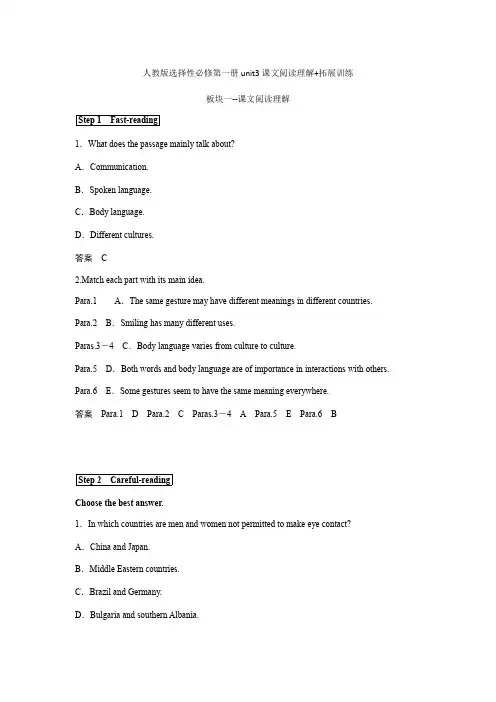
人教版选择性必修第一册unit3课文阅读理解+拓展训练板块一--课文阅读理解Step 1Fastreading1.What does the passage mainly talk about?A.Communication.B.Spoken language.C.Body language.D.Different cultures.答案C2.Match each part with its main idea.Para.1A.The same gesture may have different meanings in different countries. Para.2 B.Smiling has many different uses.Paras.3-4 C.Body language varies from culture to culture.Para.5 D.Both words and body language are of importance in interactions with others. Para.6 E.Some gestures seem to have the same meaning everywhere.答案Para.1D Para.2C Paras.3-4A Para.5E Para.6BStep 2CarefulreadingChoose the best answer.1.In which countries are men and women not permitted to make eye contact? A.China and Japan.B.Middle Eastern countries.C.Brazil and Germany.D.Bulgaria and southern Albania.2.How does the passage develop(展开)?A.By giving examples.B.By giving data.C.By giving definition(定义).D.By analysing facts.3.What can we learn from the passage?A.In all countries,shaking the head means “No”.B.A smile can get a person into difficult situations.C.In Russia,people favour bowing from the waist when they meet someone else.D.If a person moves his hand in circles over his stomach after a meal,that means he is full. 4.Which proverb can best describe the main idea of the passage?A.Never too old to learn.B.When in Rome,do as the Romans do.C.Four eyes see more than two.D.Every country has its own customs.5.Which of the following can NOT be conveyed(传达) through the gesture of “smiling”?A.Apology. B.Greeting.C.Anger. D.Asking for help.答案BADBCStep 3PostreadingAfter reading the passage,please fill in the following blanks.Gestures can 1._______(use) to express people’s thoughts and opinions in their interactions 2.____ other people,but in different countries the same gesture may have different meanings.For example,in some countries,looking into the eyes of the person you are talking to 3.___(be) a way to display interest,but in many Middle Eastern countries men and women should avoid4.________(make) eye contact.In most countries,5._______(shake) one’s head means “no”,and nodding means “yes”.By6._______(compare),in Bulgaria and southern Albania,the gestures have the opposite meaning.In countries7._____ France and Russia,people may kiss their friends on8._____ cheek when they meet.Elsewhere,people favour shaking hands,bowing from the waist,or nodding the head when they meet someone else.All in all,body language 9._______(vary) from culture to culture,but it is safe 10._________(follow) the golden rule—When in Rome,do as the Romans do.1.be used 2 with 3 is 4 making 5 shaking6 comparison7 like 8 the 9 varies 10 to followStep 4Sentencelearning1.Words are important,but the way people stand,hold their arms,and move their hands can also give us information about their feelings.______________________________________________________________2.In many countries,shaking one’s head means “no”,and nodding means “yes”.______________________________________________________________3.And if we are feeling down or lonely,there is nothing better than seeing the smiling face of a good friend.______________________________________________________________1[句式分析]本句是一个由but连接的并列句。
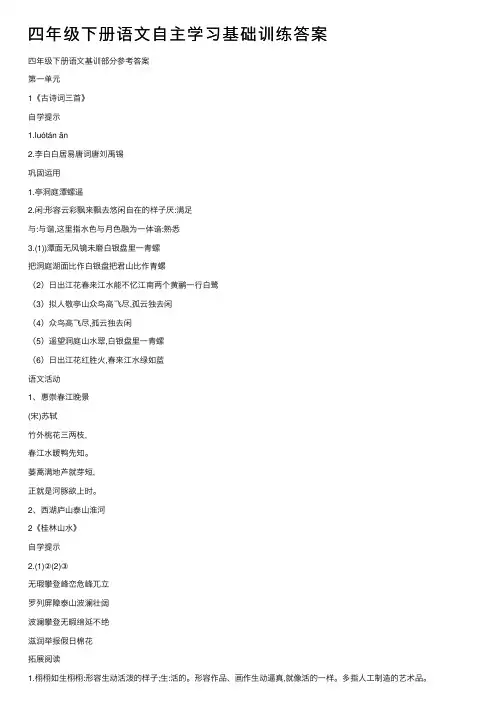
四年级下册语⽂⾃主学习基础训练答案四年级下册语⽂基训部分参考答案第⼀单元1《古诗词三⾸》⾃学提⽰1.luótán ān2.李⽩⽩居易唐词唐刘禹锡巩固运⽤1.亭洞庭潭螺遥2.闲:形容云彩飘来飘去悠闲⾃在的样⼦厌:满⾜与:与谐,这⾥指⽔⾊与⽉⾊融为⼀体谙:熟悉3.(1))潭⾯⽆风镜未磨⽩银盘⾥⼀青螺把洞庭湖⾯⽐作⽩银盘把君⼭⽐作青螺(2)⽇出江花春来江⽔能不忆江南两个黄鹂⼀⾏⽩鹭(3)拟⼈敬亭⼭众鸟⾼飞尽,孤云独去闲(4)众鸟⾼飞尽,孤云独去闲(5)遥望洞庭⼭⽔翠,⽩银盘⾥⼀青螺(6)⽇出江花红胜⽕,春来江⽔绿如蓝语⽂活动1、惠崇春江晚景(宋)苏轼⽵外桃花三两枝,春江⽔暖鸭先知。
蒌蒿满地芦就芽短,正就是河豚欲上时。
2、西湖庐⼭泰⼭淮河2《桂林⼭⽔》⾃学提⽰2.(1)②(2)③⽆瑕攀登峰峦危峰兀⽴罗列屏障泰⼭波澜壮阔波澜攀登⽆暇绵延不绝滋润举报假⽇棉花拓展阅读1.栩栩如⽣栩栩:形容⽣动活泼的样⼦;⽣:活的。
形容作品、画作⽣动逼真,就像活的⼀样。
多指⼈⼯制造的艺术品。
相映成趣: 指相互衬托着,显得很有趣味,很有意思。
2.半江渡画⼭黄布滩碧莲峰3、“只见两岸群⼭如千万株⽟笋破⼟⽽出,青翠欲滴,碧波倒影,⼭⽔含情,宛若置⾝仙境。
碧莲峰玲珑、俊秀,很像⼀朵朵含苞欲放的莲花,⽣意盎然。
”语⽂活动1、长城2、九曲⼗⼋弯3、九寨沟4、黄⼭3《记⾦华的双龙洞》⾃学提⽰2.叶圣陶游记浙江⾦华的双龙洞4⽉14⽇BACED按游览顺序记叙、运⽤恰当的词汇描绘事物特点与表达⾃⼰的真实感受。
巩固运⽤擦伤蜿蜒钟乳源2.盘曲各异森郁多端3.(1)宽—窄缓—急(2)溪流蜿蜒曲折,由于溪流的宽窄不⼀才形成流⽔速度的缓急不同。
4.(1)稍微额⾓擦伤作者通过孔隙时的真实感受以及孔隙窄⼩与矮的特点。
(2)变化多端颜⾊各异观赏形状颜⾊拓展阅读1.惟妙惟肖(xiào ):形容描写或模仿得⾮常⽣动,或就是雕刻得⾮常精美、⼗分逼真。
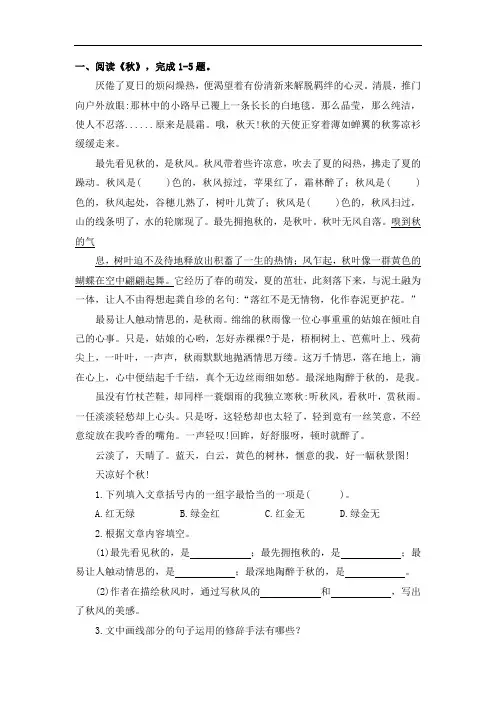
一、阅读《秋》,完成1-5题。
厌倦了夏日的烦闷燥热,便渴望着有份清新来解脱羁绊的心灵。
清晨,推门向户外放眼:那林中的小路早已覆上一条长长的白地毯。
那么晶莹,那么纯洁,使人不忍落......原来是晨霜。
哦,秋天!秋的天使正穿着薄如蝉翼的秋雾凉衫缓缓走来。
最先看见秋的,是秋风。
秋风带着些许凉意,吹去了夏的闷热,拂走了夏的躁动。
秋风是( )色的,秋风掠过,苹果红了,霜林醉了;秋风是( )色的,秋风起处,谷穗儿熟了,树叶儿黄了;秋风是( )色的,秋风扫过,山的线条明了,水的轮廓现了。
最先拥抱秋的,是秋叶。
秋叶无风自落。
嗅到秋的气息,树叶迫不及待地释放出积蓄了一生的热情;风乍起,秋叶像一群黄色的蝴蝶在空中翩翩起舞。
它经历了春的萌发,夏的茁壮,此刻落下来,与泥土融为一体,让人不由得想起龚自珍的名句:“落红不是无情物,化作春泥更护花。
”最易让人触动情思的,是秋雨。
绵绵的秋雨像一位心事重重的姑娘在倾吐自己的心事。
只是,姑娘的心哟,怎好赤裸裸?于是,梧桐树上、芭蕉叶上、残荷尖上,一叶叶,一声声,秋雨默默地抛洒情思万缕。
这万千情思,落在地上,滴在心上,心中便结起千千结,真个无边丝雨细如愁。
最深地陶醉于秋的,是我。
虽没有竹杖芒鞋,却同样一蓑烟雨的我独立寒秋:听秋风,看秋叶,赏秋雨。
一任淡淡轻愁却上心头。
只是呀,这轻愁却也太轻了,轻到竟有一丝笑意,不经意绽放在我吟香的嘴角。
一声轻叹!回眸,好舒服呀,顿时就醉了。
云淡了,天晴了。
蓝天,白云,黄色的树林,惬意的我,好一幅秋景图!天凉好个秋!1.下列填入文章括号内的一组字最恰当的一项是( )。
A.红无绿B.绿金红C.红金无D.绿金无2.根据文章内容填空。
(1)最先看见秋的,是;最先拥抱秋的,是;最易让人触动情思的,是;最深地陶醉于秋的,是。
(2)作者在描绘秋风时,通过写秋风的和,写出了秋风的美感。
3.文中画线部分的句子运用的修辞手法有哪些?4.“姑娘的心的,怎好赤裸裸?将这句话改为陈述句。
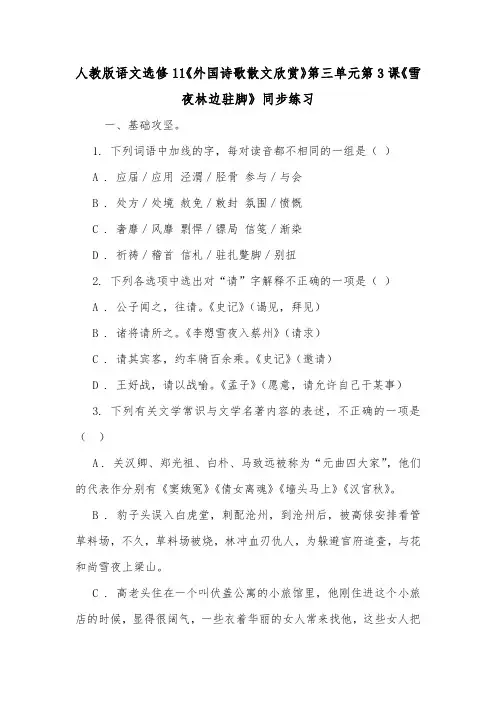
人教版语文选修11《外国诗歌散文欣赏》第三单元第3课《雪夜林边驻脚》同步练习一、基础攻坚。
1. 下列词语中加线的字,每对读音都不相同的一组是()A . 应届/应用泾渭/胫骨参与/与会B . 处方/处境赦免/敕封氛围/愤慨C . 奢靡/风靡剽悍/镖局信笺/渐染D . 祈祷/稽首信札/驻扎蹩脚/别扭2. 下列各选项中选出对“请”字解释不正确的一项是()A . 公子闻之,往请。
《史记》(谒见,拜见)B . 诸将请所之。
《李愬雪夜入蔡州》(请求)C . 请其宾客,约车骑百余乘。
《史记》(邀请)D . 王好战,请以战喻。
《孟子》(愿意,请允许自己干某事)3. 下列有关文学常识与文学名著内容的表述,不正确的一项是()A . 关汉卿、郑光祖、白朴、马致远被称为“元曲四大家”,他们的代表作分别有《窦娥冤》《倩女离魂》《墙头马上》《汉宫秋》。
B . 豹子头误入白虎堂,刺配沧州,到沧州后,被高俅安排看管草料场,不久,草料场被烧,林冲血刃仇人,为躲避官府追查,与花和尚雪夜上梁山。
C . 高老头住在一个叫伏盖公寓的小旅馆里,他刚住进这个小旅店的时候,显得很阔气,一些衣着华丽的女人常来找他,这些女人把高老头身上的金银饰物一件件带走了。
D . 法国作家莫泊桑、俄国作家契诃夫和美国作家欧·亨利以写短篇小说名噪于世,有“世界三大短篇小说之王”的美称。
4. 下列语段的语序已被打乱,其中排序正确的一项是()①“柴门闻犬吠,风雪夜归人”,是江南雪夜,更深人静后的景况。
②“寒沙梅影路,微雪酒香村”,则雪月梅的冬宵三友,会合在一道,在调戏酒姑娘了。
③“晚来天欲雪,能饮一杯无?”自然是江南日暮的雪景。
④“前树深雪里,昨夜一枝开”,又到了第二天的早晨,和狗一样喜欢弄雪的村童来报告村景了。
⑤一提到雨,也就必然的要想到雪。
A . ⑤①②③④B . ⑤④③②①C . ⑤③②①④D . ⑤①③②④5. 下列句子中加框词的用法与其他三项不同的一项是()A . 艰难苦恨繁霜鬓B . 襟三江而带五湖C . 昨夜西风凋碧树D . 直可惊天地,泣鬼神6. 下列各句中,没有语病的一句是()A . 针对中国驻美大使崔天凯批评美国国防部长哈格尔日前有关钓鱼岛言论不符合事实并暗劝美方“勿搬日本这块石头砸自己的脚”,美国国务院1日回应称,美方希望避免采取引发紧张局势的行动的话是说给双方听的,美国对钓鱼岛最终主权不持立场。
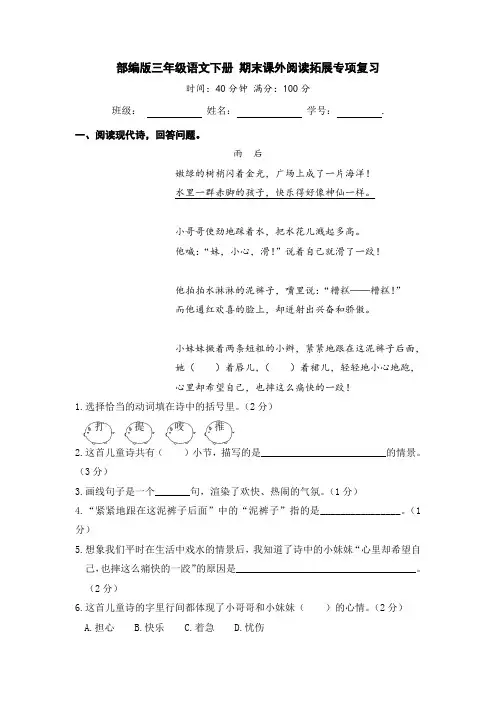
部编版三年级语文下册期末课外阅读拓展专项复习时间:40分钟满分:100分班级:姓名:学号: .一、阅读现代诗,回答问题。
雨后嫩绿的树梢闪着金光,广场上成了一片海洋!水里一群赤脚的孩子,快乐得好像神仙一样。
小哥哥使劲地踩着水,把水花儿溅起多高。
他喊:“妹,小心,滑!”说着自己就滑了一跤!他拍拍水淋淋的泥裤子,嘴里说:“糟糕——糟糕!”而他通红欢喜的脸上,却迸射出兴奋和骄傲。
小妹妹撅着两条短粗的小辫,紧紧地跟在这泥裤子后面,她()着唇儿,()着裙儿,轻轻地小心地跑,心里却希望自己,也摔这么痛快的一跤!1.选择恰当的动词填在诗中的括号里。
(2分)打提咬推2.这首儿童诗共有()小节,描写的是_________________________的情景。
(3分)3.画线句子是一个_______句,渲染了欢快、热闹的气氛。
(1分)4.“紧紧地跟在这泥裤子后面”中的“泥裤子”指的是________________。
(1分)5.想象我们平时在生活中戏水的情景后,我知道了诗中的小妹妹“心里却希望自己,也摔这么痛快的一跤”的原因是____________________________________。
(2分)6.这首儿童诗的字里行间都体现了小哥哥和小妹妹()的心情。
(2分)A.担心B.快乐C.着急D.忧伤二、阅读下面的寓言故事,完成练习。
刻舟求剑战国时,楚国有个人坐船渡江。
船到江心,楚人一不小心,随身携带的一把宝剑滑落江中,他赶紧伸手去抓,可惜为时已晚,宝剑已经落入江中。
船上的人对此感到非常惋惜。
但那楚人似乎胸有成竹,马上掏出一把小刀,在船舷上刻上个记号,并且对大家说:“这是宝剑落水的地方,所以我要刻上一个记号。
”大家都不理解他为何要这样做,也不再去问他。
船靠岸后,那楚人立即在船上刻有记号的地方下水,去捞取掉落的宝剑。
楚人捞了半天,始终不见宝剑的影子。
他觉得很奇怪,自言自语地说:“我的宝剑不就是从这里掉下去的吗?我还在这里刻上了记号,现在怎么会找不到呢?”听他这么一说,那些人纷纷大笑起来,说道:“船一直在行进,而你的宝剑却沉入了水底,不会随船移动,你又怎能找得到你的剑呢?”1.下面句子中的“惜”字应该是哪一种解释?(填序号)(2分)A.爱惜,重视,不随便丢弃。
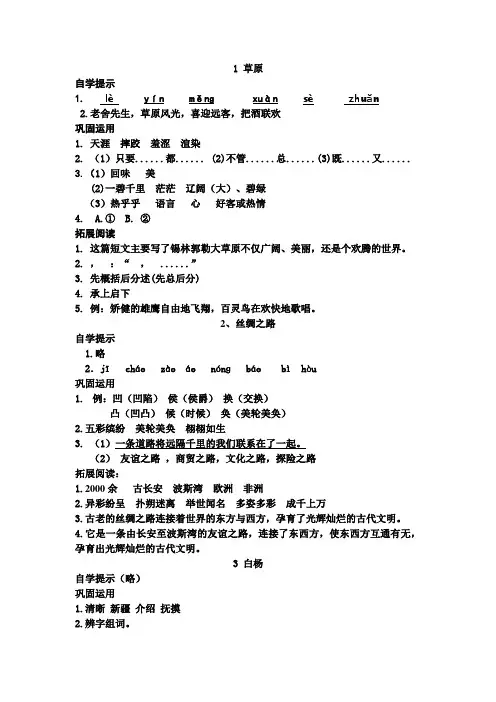
1 草原自学提示1. lè yín měnɡ xuàn sèzhuăn2.老舍先生,草原风光,喜迎远客,把酒联欢巩固运用1.天涯摔跤羞涩渲染2.(1)只要......都...... (2)不管......总......(3)既......又......3.(1)回味美(2)一碧千里茫茫辽阔(大)、碧绿(3)热乎乎语言心好客或热情4. A.① B. ②拓展阅读1.这篇短文主要写了锡林郭勒大草原不仅广阔、美丽,还是个欢腾的世界。
2.,:“, ......”3.先概括后分述(先总后分)4.承上启下5.例:矫健的雄鹰自由地飞翔,百灵鸟在欢快地歌唱。
2、丝绸之路自学提示1.略2.jī cháo zào áo nónɡ báo bì hòu巩固运用1.例:凹(凹陷)侯(侯爵)换(交换)凸(凹凸)候(时候)奂(美轮美奂)2.五彩缤纷美轮美奂栩栩如生3. (1)一条道路将远隔千里的我们联系在了一起。
(2)友谊之路,商贸之路,文化之路,探险之路拓展阅读:1.2000余古长安波斯湾欧洲非洲2.异彩纷呈扑朔迷离举世闻名多姿多彩成千上万3.古老的丝绸之路连接着世界的东方与西方,孕育了光辉灿烂的古代文明。
4.它是一条由长安至波斯湾的友谊之路,连接了东西方,使东西方互通有无,孕育出光辉灿烂的古代文明。
3 白杨自学提示(略)巩固运用1.清晰新疆介绍抚摸2.辨字组词。
僵(僵硬)辩(争辩)晰(清晰)缰(缰绳)辨(辨别)晳(白皙)疆(新疆)辫(辫子)淅(淅淅沥沥)3.略4.根据课文的理解填空。
(1)山,水,人烟,清晰,浑黄一体。
荒凉,干燥恶劣,恶劣,不择环境、生命力顽强。
(2)白杨树,边疆建设者,借物喻人。
拓展阅读1.这就是白杨树,西北极普通的一种树,然而决不是平凡的树。
2.(1)好女子伟丈夫(2)4 排比北方的农民哨兵赞美和敬佩3.极其普通,不被人重视;有极强的生命力,折磨不了,压迫不倒。
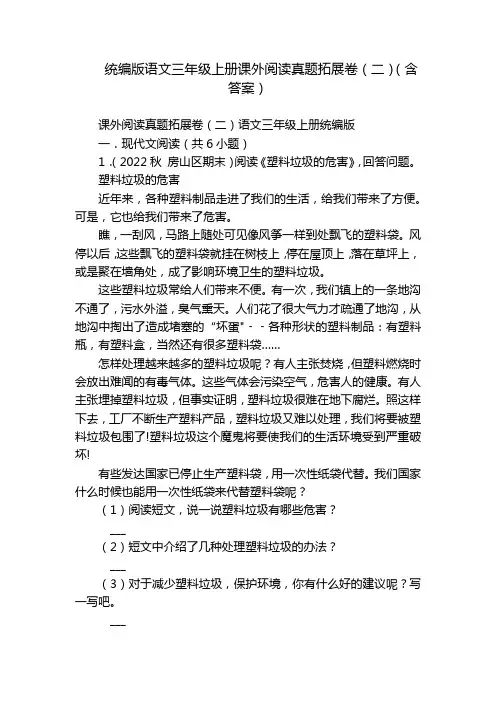
统编版语文三年级上册课外阅读真题拓展卷(二)(含答案)课外阅读真题拓展卷(二)语文三年级上册统编版一.现代文阅读(共6小题)1.(2022秋房山区期末)阅读《塑料垃圾的危害》,回答问题。
塑料垃圾的危害近年来,各种塑料制品走进了我们的生活,给我们带来了方便。
可是,它也给我们带来了危害。
瞧,一刮风,马路上随处可见像风筝一样到处飘飞的塑料袋。
风停以后,这些飘飞的塑料袋就挂在树枝上,停在屋顶上,落在草坪上,或是聚在墙角处,成了影响环境卫生的塑料垃圾。
这些塑料垃圾常给人们带来不便。
有一次,我们镇上的一条地沟不通了,污水外溢,臭气熏天。
人们花了很大气力才疏通了地沟,从地沟中掏出了造成堵塞的“坏蛋"﹣﹣各种形状的塑料制品:有塑料瓶,有塑料盒,当然还有很多塑料袋……怎样处理越来越多的塑料垃圾呢?有人主张焚烧,但塑料燃烧时会放出难闻的有毒气体。
这些气体会污染空气,危害人的健康。
有人主张埋掉塑料垃圾,但事实证明,塑料垃圾很难在地下腐烂。
照这样下去,工厂不断生产塑料产品,塑料垃圾又难以处理,我们将要被塑料垃圾包围了!塑料垃圾这个魔鬼将要使我们的生活环境受到严重破坏!有些发达国家已停止生产塑料袋,用一次性纸袋代替。
我们国家什么时候也能用一次性纸袋来代替塑料袋呢?(1)阅读短文,说一说塑料垃圾有哪些危害?___(2)短文中介绍了几种处理塑料垃圾的办法?___(3)对于减少塑料垃圾,保护环境,你有什么好的建议呢?写一写吧。
___2.(2022秋昌平区期末)火红的枫叶今天□我在树林里走来走去□想寻找一片火红的枫叶□每当我拾(shí)起一片枫叶的时候,我总以为找到了一片最红的。
可是不久,我又找到一片更红的。
啊,我终于找到了一片最红最红的枫叶!它比朝霞(zhāo xiá)还红,比玫瑰(méi gui)还红。
火红的枫叶好像我小小的手掌。
我把这最红最红的枫叶贴在一张洁白的纸上,画上蓝天、太阳、小草,再写上一首小诗,做成一张贺卡。
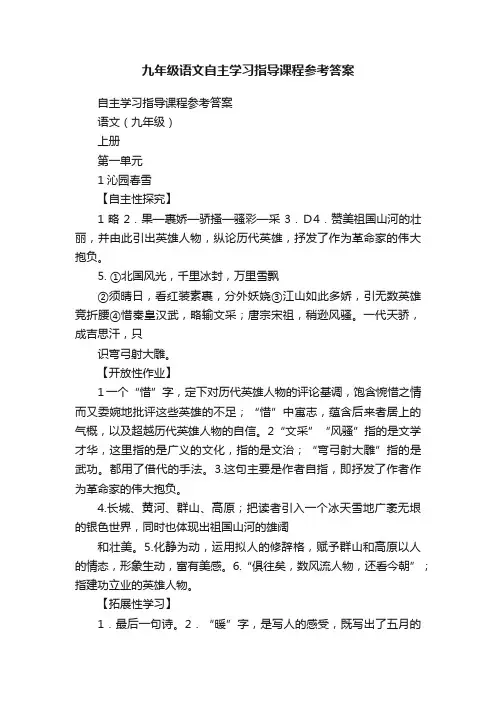
九年级语文自主学习指导课程参考答案自主学习指导课程参考答案语文(九年级)上册第一单元1沁园春雪【自主性探究】1略2.果—裹娇—骄搔—骚彩—采3.D4.赞美祖国山河的壮丽,并由此引出英雄人物,纵论历代英雄,抒发了作为革命家的伟大抱负。
5. ①北国风光,千里冰封,万里雪飘②须晴日,看红装素裹,分外妖娆③江山如此多娇,引无数英雄竞折腰④惜秦皇汉武,略输文采;唐宗宋祖,稍逊风骚。
一代天骄,成吉思汗,只识弯弓射大雕。
【开放性作业】1一个“惜”字,定下对历代英雄人物的评论基调,饱含惋惜之情而又委婉地批评这些英雄的不足;“惜”中寓志,蕴含后来者居上的气概,以及超越历代英雄人物的自信。
2“文采”“风骚”指的是文学才华,这里指的是广义的文化,指的是文治;“弯弓射大雕”指的是武功。
都用了借代的手法。
3.这句主要是作者自指,即抒发了作者作为革命家的伟大抱负。
4.长城、黄河、群山、高原;把读者引入一个冰天雪地广袤无垠的银色世界,同时也体现出祖国山河的雄阔和壮美。
5.化静为动,运用拟人的修辞格,赋予群山和高原以人的情态,形象生动,富有美感。
6.“俱往矣,数风流人物,还看今朝”;指建功立业的英雄人物。
【拓展性学习】1.最后一句诗。
2.“暖”字,是写人的感受,既写出了五月的金沙江风高浪急、暖气蒸腾的实景,又烘托了红军战士渡江脱险的喜悦和一片沸腾的景象。
“寒”突出大渡河泸定桥险恶的环境,战斗的激烈,表现红军克服一切艰难险阻的英雄形象。
3.略【学以致用】4.合乎题意即可,示例:做山一样的人/不一定高大巍峨/但定要庄重挺立;或:做水一样的人/不一定波澜壮阔/但必定清澈明净。
2雨说【自主性探究】1略2.A3.(1)初春时淡淡的余寒;停滞,不流通。
(2)这里借用来指忍受冬寒。
4.略5.结构作用:是“雨”诉说着内容变化和情感递进的线索;内容要点分别为:①第1节,雨来探访四月的大地;②第4节,雨告诉孩子们,它是来亲近他们的;③第6节,雨告诉孩子们,它是笑着长大的;④第9节,雨交代它最终的归宿。
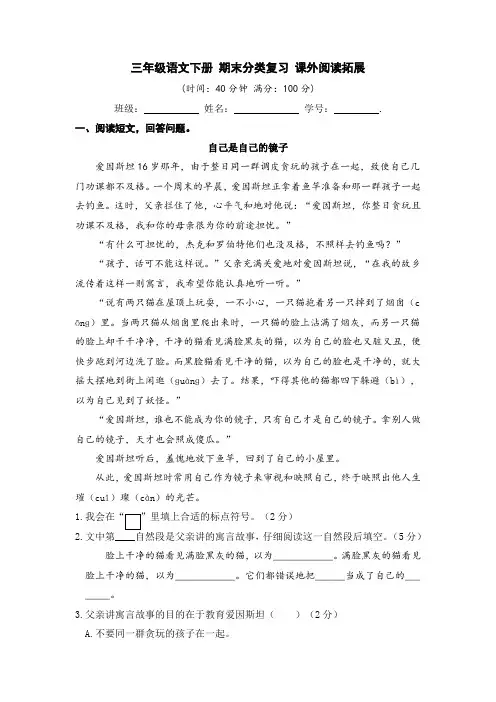
三年级语文下册期末分类复习课外阅读拓展(时间:40分钟满分:100分)班级:姓名:学号: .一、阅读短文,回答问题。
自己是自己的镜子爱因斯坦16岁那年,由于整日同一群调皮贪玩的孩子在一起,致使自己几门功课都不及格。
一个周末的早晨,爱因斯坦正拿着鱼竿准备和那一群孩子一起去钓鱼。
这时,父亲拦住了他,心平气和地对他说:“爱因斯坦,你整日贪玩且功课不及格,我和你的母亲很为你的前途担忧。
”“有什么可担忧的,杰克和罗伯特他们也没及格,不照样去钓鱼吗?”“孩子,话可不能这样说。
”父亲充满关爱地对爱因斯坦说,“在我的故乡流传着这样一则寓言,我希望你能认真地听一听。
”“说有两只猫在屋顶上玩耍,一不小心,一只猫抱着另一只掉到了烟囱(c ōnɡ)里。
当两只猫从烟囱里爬出来时,一只猫的脸上沾满了烟灰,而另一只猫的脸上却干干净净,干净的猫看见满脸黑灰的猫,以为自己的脸也又脏又丑,便快步跑到河边洗了脸。
而黑脸猫看见干净的猫,以为自己的脸也是干净的,就大摇大摆地到街上闲逛(ɡuànɡ)去了。
结果,吓得其他的猫都四下躲避(bì),以为自己见到了妖怪。
”“爱因斯坦,谁也不能成为你的镜子,只有自己才是自己的镜子。
拿别人做自己的镜子,天才也会照成傻瓜。
”爱因斯坦听后,羞愧地放下鱼竿,回到了自己的小屋里。
从此,爱因斯坦时常用自己作为镜子来审视和映照自己,终于映照出他人生璀(cuǐ)璨(càn)的光芒。
2分)1.2.文中第____自然段是父亲讲的寓言故事,仔细阅读这一自然段后填空。
(5分)脸上干净的猫看见满脸黑灰的猫,以为____________。
满脸黑灰的猫看见脸上干净的猫,以为____________。
它们都错误地把______当成了自己的___ _____。
3.父亲讲寓言故事的目的在于教育爱因斯坦()(2分)A.不要同一群贪玩的孩子在一起。
B.不要去钓鱼。
C.不要和贪玩的孩子比,他们有自己的长处。
D.不要拿别人做自己的镜子,只有自己才是自己的镜子。
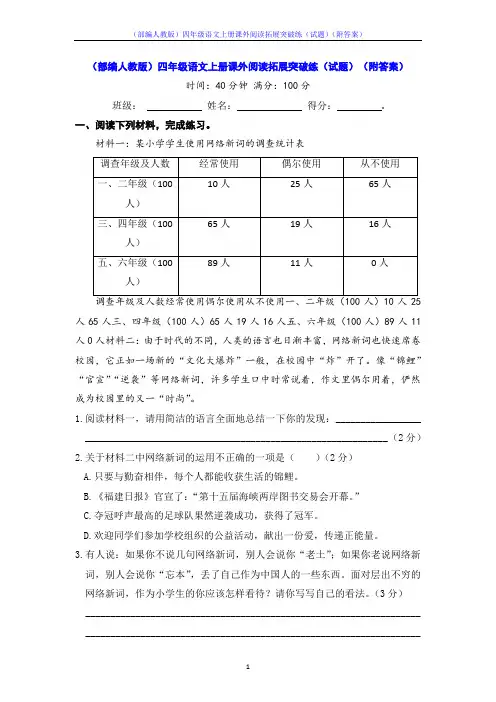
(部编人教版)四年级语文上册课外阅读拓展突破练(试题)(附答案)时间:40分钟满分:100分班级:姓名:得分:.一、阅读下列材料,完成练习。
材料一:某小学学生使用网络新词的调查统计表调查年级及人数经常使用偶尔使用从不使用10人25人65人一、二年级(100人)三、四年级(10065人19人16人人)89人11人0人五、六年级(100人)人65人三、四年级(100人)65人19人16人五、六年级(100人)89人11人0人材料二:由于时代的不同,人类的语言也日渐丰富,网络新词也快速席卷校园,它正如一场新的“文化大爆炸”一般,在校园中“炸”开了。
像“锦鲤”“官宣”“逆袭”等网络新词,许多学生口中时常说着,作文里偶尔用着,俨然成为校园里的又一“时尚”。
1.阅读材料一,请用简洁的语言全面地总结一下你的发现:_________________ ____________________________________________________________(2分)2.关于材料二中网络新词的运用不正确的一项是()(2分)A.只要与勤奋相伴,每个人都能收获生活的锦鲤。
B.《福建日报》官宣了:“第十五届海峡两岸图书交易会开幕。
”C.夺冠呼声最高的足球队果然逆袭成功,获得了冠军。
D.欢迎同学们参加学校组织的公益活动,献出一份爱,传递正能量。
3.有人说:如果你不说几句网络新词,别人会说你“老土”;如果你老说网络新词,别人会说你“忘本”,丢了自己作为中国人的一些东西。
面对层出不穷的网络新词,作为小学生的你应该怎样看待?请你写写自己的看法。
(3分)___________________________________________________________________ ___________________________________________________________________二、阅读短文,按要求回答问题。
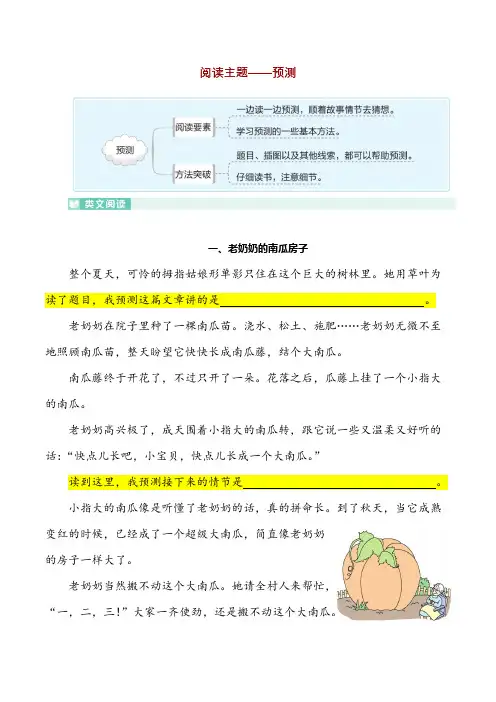
阅读主题——预测一、老奶奶的南瓜房子整个夏天,可怜的拇指姑娘形单影只住在这个巨大的树林里。
她用草叶为读了题目,我预测这篇文章讲的是。
老奶奶在院子里种了一棵南瓜苗。
浇水、松土、施肥……老奶奶无微不至地照顾南瓜苗,整天盼望它快快长成南瓜藤,结个大南瓜。
南瓜藤终于开花了,不过只开了一朵。
花落之后,瓜藤上挂了一个小指大的南瓜。
老奶奶高兴极了,成天围着小指大的南瓜转,跟它说一些又温柔又好听的话:“快点儿长吧,小宝贝,快点儿长成一个大南瓜。
”读到这里,我预测接下来的情节是。
小指大的南瓜像是听懂了老奶奶的话,真的拼命长。
到了秋天,当它成熟变红的时候,已经成了一个超级大南瓜,简直像老奶奶的房子一样大了。
老奶奶当然搬不动这个大南瓜。
她请全村人来帮忙,“一,二,三!”大家一齐使劲,还是搬不动这个大南瓜。
老奶奶一点儿也不介意,她说:“就让它留在院子里吧。
”老奶奶非常喜欢这个大南瓜,每天都要去看看它,用手摸摸它。
白天,老奶奶搬把凳子,靠在南瓜旁边织毛衣。
到了晚上,老奶奶回房子里睡觉,可心里还是惦记着大南瓜,总是睡不安稳。
有一天,老奶奶灵机一动,想出了一个好办法。
冬天到来的时候,老奶奶请人在大南瓜上开了一道门和一扇窗户,在南瓜顶上挖了一个烟囱。
这样一来,大南瓜变成了大房子。
老奶奶住进红红的南瓜房子里,快活极了。
1【语文要素】读故事,根据提示预测故事情节,写一写。
2【梳理内容】读完故事后,根据提示梳理故事情节。
3【品读句子】读画“”的句子,体会作者是如何把人物描写得鲜活的,猜测人物的心理活动。
老奶奶惦记着大南瓜,她想:4【拓展思维】老奶奶请人在大南瓜上开了一道门和一扇窗户,在顶上挖了一个烟囱。
在老奶奶设计的基础上,你还有什么新的想法呢?想一想,说一说。
二、月亮的味道月亮,是什么味道呢?是甜的还是咸的?真想尝一小口啊!夜里,动物们望着月亮,总是这么想。
可是呢,不管怎么伸长了脖子,伸长了手,伸长了腿,也够不着月亮。
有一天,一只小海龟下定了决心,它要一步一步爬到最高的山上,去摸一摸月亮。
课外阅读专项训练答案(人教三上)一、1.点拨:仔细阅读短文第一自然段,可以找出相应的词语。
答案:灿烂清新湿润2.点拨:通过阅读短文的前两段,可以知道清晨我在溪边读书,中午也要到溪边站一会儿。
答案:读书到溪边站一会儿3.点拨:从短文的每一段的第一个词,可以知道是按照时间顺序写的。
答案:时间清晨中午晚上4.点拨:仔细阅读短文最后一自然段,可以找到答案。
答案:晚上,月影躺在水底,星星眨眼睛,云彩也高兴地跑进来,用拟人的手法将作者带入到了一个完全不同的童话般美丽的世界。
二、1.点拨:仔细阅读第二段和第三段就可以找出答案。
答案:龙、森林、仙鹤、太乙真人、哪吒1.点拨:文中的“出神”,表示看呆了。
答案:(1)×(2)√(3)√2.这是动画片《哪吒闹海》中的师傅—太乙真人。
4.点拨:文中有很多好词好句,值得学习积累。
示例:词语:上游下窜吞云吐雾枝繁叶茂句子:红红的太阳落山了,它收起余晖,只剩下一个柔和、鲜艳的火球,颜色金黄透亮,就是技艺高超的画家也难以描绘。
三、1. 点拨:根据古诗上面的标注或自己的知识积累回答。
答案:唐王维唐刘禹锡2. 点拨:对比《山行》和《夜书所见》来回答。
答案:杜牧霜叶风声夜书所见萧萧梧叶送寒声3. 点拨:熟读古诗,抓住重点词语理解。
答案:(1)白石粼粼无边的浓翠(2)秋风思乡四、1.点拨:近义词是指词汇意义相同或相近的词语,如“美好”和“美妙”“懒惰”和“怠惰”“枯萎”和“干枯”“宽敞”和“宽阔”。
答案:出现辛苦2.点拨:联系上下文可以知道这两个词的意思。
答案:(1)好听。
(2)这里起来,那里落下,表示连续不断。
3.点拨:比喻句,就是打比方,用浅显、具体、生动的事物来代替抽象、难理解的事物。
拟人句就是把某件东西比喻成有人的动作,而不是像童话形式。
答案:秋天里,盛开的菊花,衬托着红红的枫叶,像一幅美丽的图画。
金黄色的稻穗弯了腰,轻吻着大地。
4.点拨:仔细阅读短文,就能找出这些动植物。
1 11级拓展班自主学习阅读任务(三) Weeks 12-15 Topic 3: Culture and Me
1. 阅读任务(Reading assignments): 请同学们认真阅读老师提供的有关Topic3 的阅读材料(请见以下第3点)。这些材料主要来源于你们手上的书本,我们会以书本名称、第几册、第几unit等方式为大家提供自主学习阅读内容。为了增加大家的课外阅读量,使大家拥有可供讨论的更多素材和信息,我们为大家组织了一些与Topic 3主题相关的其它阅读材料。 请同学们采取独立与小组合作学习相结合的方式完成阅读任务。首先每位同学独立完成Topic 3的相关材料的阅读,然后与小组伙伴们一起在寝室、教室、图书馆阅览室等地,或者通过手机、网络等渠道根据以下Framework of KWLC for Reading Review表格里的内容讨论你的阅读理解和想法,在形成自己的观点后撰写一篇有关Topic 3的阅读评论。评论的字数要求在300英文词左右,内容可以根据Framework of KWLC for Reading Review中的几个与你的合作伙伴们讨论过的问题来写。
附:Framework of KWLC for Reading Review (K) What do I know about this topic? (W) What do I want to know about this topic? (L) What did I learn from the provided reading materials and also my group members? (C) What do I want to comment on what I learned?
2.阅读任务学习评价方式: Topic 2 的阅读评论作业要求在Dec. 17, 2012前完成。 请同学们务必在该截止时间前把阅读评论作业通过“新理念外语网络教学平台”的“作业”栏目上传给你的任课老师。逾期提交作业,任课老师将不接收;不交作业,任课老师将从你的考勤10分总成绩中扣除一分成绩。 2
3. 阅读材料: I.书本材料 1. 《全新版大学英语综合教程》(Book 3) Unit 5 Giving Thanks(Text A, Text B) 2. 《新世纪大学英语快速阅读》(Book 1) Unit 7 Christmas (P113-127) 3. 《新世纪大学英语快速阅读》(Book 2) Unit 3 Cuisine (P31-43) 4. 《新世纪大学英语快速阅读》(Book 2) Unit 5 Culture (P61-72) 5. 《新世纪大学英语快速阅读》(Book 3) Unit 1 Customs and Festivals (P1-12)
II.其它材料 Passage 1: On the Differences between Chinese and Western Culture
What is culture? Within the broadest sense, culture is humanized nature. Everything that is related to human beings' activity can be referred to as culture. Culture is a reflect of human's life, a record of human's activities, and a kind of historical sediment. It represents people's need and requirement, as well as ideal and desire towards life. It is human's behavior to make acquaintance of the nature and at the same time think about themselves. Besides, it symbolizes a framework supporting human's spirits.
A. Cultural Differences in Etiquette 1. Differences in Communicative Manners Firstly, there is dissimilarity in meeting each other. The Chinese people usually introduce more intimate small talks, such as "Have you eaten?", "where are you going?", or "what are you doing?". While such greeting may be considered to be intrusive or embarrassed for the westerners since they may misunderstand it as a kind of "interrogation" about their private lives. In western countries, people meet each other only with a simple "hello", or more specifically, they will say "Good morning!", "Good afternoon!", or "Good evening!" But for some countries like UK, people prefer to talking about weather, and they usually begin with "It is a nice day today."
As for the title, in China, the real name is only available when people are intimate with each other. Whereas in western countries, it is more often used. The westerners will address "Sir" and "Madam" before an unknown stranger, "Miss" before a girl of ten or twenties, and "Ms" or "Mrs" before a married woman. When it comes to family members, first names or nicknames are all acceptable. People can call their Dad's or Mam's first name at home. They can also call all the male elders as "Uncle" and all the female elders as "Aunt". 3
However, it is not the same thing in China. We must be aware of the relations between the youngers and the elders, or we may be considered as impolite.
In addition, there are various farewell words in the Chinese and the Western languages. For example, when leaving a patient, we Chinese people usually say "Drink much water.", "Put on more clothes." or "Have a rest". While the westerners will never say like that, because it may be considered as "impolite behavior". Instead, they will choose words like "Take care." or "Get well soon."
2.Differences in Food and Drinking There is an old saying in China "Food is the utmost necessity of people", from which we can sense the key position of food in Chinese people. Therefore, the Chinese people view eating as the most important thing.
The Chinese food focuses more on the integration of color, smell, taste, appearance and embodiment than nutrition. As long as it is tasty and inviting, the nutrition then is not that important. Whereas, the westerners hold a scientific view on food that focuses much on nutrition's collocation and absorption. They usually take nutrition as the most important thing no matter how the dish looks, smells, tastes. They are less keen on taste but more for survival and health.
As for the eating environment, the Chinese people like livelihood and excitement with many people crowded together drinking and eating, creating a warm environment. Except for formal banquet, there is no special eating manners in China. While in the western countries, people prefer pleasant and quite environment. They think keeping good manners at table is important. For example, they never make noisy sound when eating.